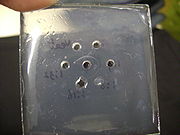
Ouchterlony Double Immuno Diffusion
Encyclopedia

Immunodiffusion
Immunodiffusion is a diagnostic test which involves diffusion through a substance such as agar.Two commonly known forms are Ouchterlony double immunodiffusion and radial immunodiffusion....
or passive double immunodiffusion) is a simple, rather dated method which is still considered to be the gold standard
Gold standard (test)
In medicine and statistics, gold standard test refers to a diagnostic test or benchmark that is the best available under reasonable conditions. It does not have to be necessarily the best possible test for the condition in absolute terms...
for detection of extractable nuclear antigens
Extractable nuclear antigens
Extractable Nuclear Antigens are soluble cytoplasmic and nuclear components that are antibody targets with over 100 different antigens described....
. It is named after Örjan Ouchterlony
Örjan Ouchterlony
Örjan Ouchterlony was a Swedish physician and immunologist who is credited with the creation of the Ouchterlony double immuno diffusion test in the 1940s...
, the Swedish physician who invented the test.
Procedure
A gel plate is cut to form a series of holes ("wells") in the gel. A sample extract of interest (for example human cells harvested from tonsil tissue) is placed in one well, and sera or purified antibodies are placed in another well and the plate left for 48 hours to develop. During this time the antigens in the sample extract and the antibodies each diffuse out of their respective wells. Where the two diffusion fronts meet, if any of the antibodies recognize any of the antigens, they will bind to the antigens and form what is known as an immune complex. This immune complex precipitates in the gel to give a thin white line, which is a visual signature of antigen recognition.The method can be conducted in parallel with multiple wells filled with different antigen mixtures and multiple wells with different antibodies or mixtures of antibodies, and antigen-antibody reactivity can be seen by observing between which wells the precipitate is observed. When more than one well is used there are many possible outcomes based on the reactivity of the antigen and antibody selected. The zone of equivalence lines may give a full identity (i.e. a continuous line), partial identity (i.e. a continuous line with a spur at one end), or a non-identity (i.e. the two lines cross completely).
Theory
Precipitation occurs with most antigens because the antigen is multivalent (i.e. has several antigenic determinants per molecule to which antibodies can bind). Antibodies have at least two antigen binding sites (and in the case of Immunoglobulin MImmunoglobulin M
Immunoglobulin M, or IgM for short, is a basic antibody that is produced by B cells. It is the primary antibody against A and B antigens on red blood cells. IgM is by far the physically largest antibody in the human circulatory system...
there is a multimeric complex with up to 10 antigen binding sites), thus large aggregates or gel-like lattices of antigen and antibody are formed. Experimentally, an increasing amount of antigen is added to a constant amount of antibody in solution. Initially at low antigen concentration, all of the antigen is contained in the precipitate. This is called the antibody-excess zone (i.e. prozone phenomenon
Prozone phenomenon
The prozone phenomenon is defined as a falsely negative test due to very high titers of antibody.Many laboratory tests rely on antigen-antibody interactions. The prozone phenomenon is said to be present when dilution of a previously negative sample leads to a positive test...
). As more antigen is added, the amount of protein precipitated increases until the antigen/antibody molecules are at an optimal ratio. This is known as the zone of equivalence or equivalence point. When the amount of antigen in solution exceeds the amount of antibody, the amount of precipitation will decrease. This is known as the antigen excess zone.
External links
- Simulator at University of California, IrvineUniversity of California, IrvineThe University of California, Irvine , founded in 1965, is one of the ten campuses of the University of California, located in Irvine, California, USA...
- Overview at University of MarylandUniversity of Maryland, College ParkThe University of Maryland, College Park is a top-ranked public research university located in the city of College Park in Prince George's County, Maryland, just outside Washington, D.C...

